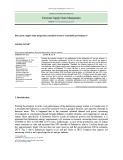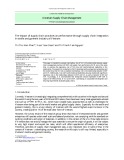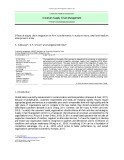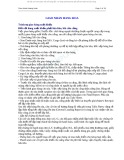
* Corresponding author
E-mail address:mereh3000@hotmail.com (M.S. Mira)
© 2019 by the authors; licensee Growing Science, Canada
doi: 10.5267/j.uscm.2018.11.005
Uncertain Supply Chain Management 7 (2019) 507–516
Contents lists available at GrowingScience
Uncertain Supply Chain Management
homepage: www.GrowingScience.com/uscm
Mediating role of port supply chain integration between involvement of human resource
practices and port performance in Kingdom of Saudi Arabia
Mohameed Saud Miraa*, Yap Voon Choonga and Chan Kok Thima
aFaculty of Management, Multimedia University, Kualalumpur, Malaysia
C H R O N I C L E A B S T R A C T
Article history:
Received October 2, 2018
Accepted November 23 2018
Available online
November 23 2018
The primary objective of this paper is to investigate the mediation role of port supply chain
integration between Human Resource Management (HRM) practices and port performance (PP)
in Kingdome of Saudi Arabia. The present study employed partial lest square structural equation
modeling technique to analyze the collected data. The study found some positive significant
direct relationship between HRP, port supply chain integration (PSCI) and PP. Besides, this study
also found some positive and significant relationship between HRP and PSCI. Additionally, the
study confirms the mediating role of PSCI between HRP and PP. The study contributes to the
literature and to the practice of ports to understand how the process of HRP and PSCI produces
better port performance.
ensee Growing Science, Canada
b
y the authors; lic9© 201
Keywords:
Port Supply Chain Integration
Human Resource Practices
Port performance
Kingdom of Saudi Arabia
1. Introduction
1.1 Background
The ports have major economic and strategic importance for countries as they facilitate imports and
exports by having connected geographical locations, subsequently fostering the local, national and
regional economy and boosting firm’s competitiveness along the entire global supply chain (Song &
Parola, 2015). In the context of Kingdom of Saudi Arabia (KSA) that is the world’s main oil exporting
country, it has the largest and most diversified economy in the Middle East with industrial exports that
are internationally oriented. The KSA should have efficient, fully equipped ports that are capable of
doing the job as it should be accomplished. The ports play a great role to increase the economy of the
country through handling the cargo of goods for imports and exports. According to Elentably (2015)
nine main ports are working in KSA, which achieved 95% of the exports and imports of commodities
through the Kingdom’s seaports while 55% of the cargos handled are exported. In addition, more than
5 million Twenty-Foot Equivalent Unit (TEUs) are handled annually and 11,000 ships visit Saudi ports
annually (Elentably, 2015). Despite the positive contribution to growth domestic product of Saudi
Arabia, cargo’s over stock is the main issue that recently came up which raise the price of cargo’s

508
handle up to 200% and resulted in lack of HRM practices such as employee recruitment & selection,
employee participation and port supply chain integration (PSCI) in cargo section (News, 2016).
The port is regarded as a significant player in global logistics and supply chain since it handles over
90%, in terms of volume, of cargoes transported over the globe (Mangan et al., 2016). However, the
growing demand for the integrated logistics serves ad intensifying port competition and a port should
collaborate and cooperate with its supply chain partners for providing value-added services to port users
(Wang & Cheng, 2010). Moreover, the concept of PSCI is gaining importance in port sector. There are
many studies that stated the importance of port in supply chain management (Bichou & Gray, 2004;
Pettit & Beresford, 2009). Nevertheless, it is not clear that PSCI is limited, whichever to labor supplier
and equipment or shipping lines and inland transport operators. However, there are very limited studies
on the relationship between PSCI and port performance.
2. Literature Review and Hypothesis Development
This section will cover the past studies discussions related to port supply chain integration (PSCI),
human resource practices (HRM) and port performance (PP). Furthermore, this portion will cover the
discussion on the relationship between the proposed variables to develop the hypotheses.
2.1 Port performance (PP)
Port performance is optimizing the connectivity, efficient operation, value added service and cost
efficiency over the competitor which could lead to competitive advantage (Notteboom & Rodrigue,
2005). The enhancement of PP marginally contributes to country development through economic
benefits and attracting more port users (Tongzon & Sawant, 2007). PP is primarily concerned with
efficiency and effectiveness of the services. However, the meaning of full assessment of PP requires a
set of antecedents of port operations and port user interest such as connectivity, safety & security, value
added service, cost efficiency, convenience of port users and cost efficiency. The objective of this paper
is to investigate the antecedents of PP empirically, such as HRM practices and PSCI.
2.2 Human Resource Practices (HRP) and Port Performance (PP)
Human resource practices could be deployed for competitive advantage leading to higher port
performance (Schuler & MacMillan, 1984). In other words, any successful organization depends on
employee performance within the firm. HRP is the multilevel construct that captures the specific
activities within the firm (Arthur & Boyles, 2007). Moreover, HRP gives information to employees on
how they will be selected, how they will interact with customers and firms and how they will be
rewarded. However, when these practices are well aligned and integrated that creates a strong HRM
system within the firm. The current study considers two main influential practices of HRM, which are
employee recruitment and selection and employee participation.
The function process to attract and select the skilled workers to reach the goals of the organizations,
once the organization attracts and chooses the employees, the organization will achieve its goals in low
cost. However, the wrong process of this function will affect the performance of the firms, in addition,
the recovery of it will be costly. Thus, the main aim of this function is to gain the goal of the
organization based on attracting and selecting the right employees (Gamage, 2014).
On the other hand, employee participation (EP) demonstrates the structure of flat organization that
gives value to employee’s opinion. Furthermore, EP helps the employee learn on how to improve
his/her job and receives desire performance or reward. However, there are two ways to improve the
employee participation and their performance such as problem-solving group and feedback. Problem
solving groups present the firm structure and give a chance to employees for participation and giving
feedback information delivering to employee that allow the employees to improve their performance
and use the feedback to adjust their efforts. Therefore, in this way employee participation indicates how

M.S. Mira et al. / Uncertain Supply Chain Management 7 (2019)
509
employees are participating in the firm. This activity is very important for any firm performance; thus,
this HR practice considers for port performance as influential factor.
Therefore, the following the hypothesis propose;
H1: There is a significant relationship between human resource practices (HRP) and port performance.
2.3 Human Resource Practices (HRP) and Port Supply Chain Integration (PSCI)
Past studies stressed that HRP facilitates building PSCI relationships and collaboration (Scarbrough,
2000). In more explanations, high incentives to employees are expected to yield desire supply chain
behavior, further, human capital can be leveraged to improve the firm supply chains. Moreover, skill
and competency of employee enhance the supply chain management. Additionally, supply chain
integration is the heart of supply chain management. The objective of this study is to investigate the
role of HRP in SCI. However, in this respect, the study of Huo et al. (2015) gives some valid evidence
that HRP influences PSCI, positively.
Furthermore, Shub and Stonebraker (2009) found the relationship between HRP and PSCI and further
stressed that a relationship between HRP and PSCI must be established. In another study, Menon (2012)
presented that the specific HR practice such as recruitment and selection improve the PSCI.
Additionally, one more study found the HRP components such as employee participation influences
positively on the port supply chain integration. Therefore, based on the past literature review discussion,
the following hypothesis is proposed.
H2: There is a significant relationship between human resource practices and port performance.
2.4 Mediating the role of port supply chain integration (PSCI) between human resource practice (HRP)
and port performance (PP)
Port supply chain integration (PSCI) is the process in which firm can coordinate and interconnected
inter-organizational and intra-organizational processes. PSCI emphasizes the link between the firm and
customers, suppliers and other channel members. Additionally, PSCI is the center of coordination,
which requires all business process be streamline internally within the firm and externally among other
firms. However, PSCI has been gaining importance day by day due to its contribution towards firm
competitive advantage which leads to firm performance such as port performance. Moreover, PSCI
conceptualization can be divided into two dimensions including customer integration and supplier
integration. Besides, the relationship between PSCI and PP has been investigated in the past studies.
Han (2018) investigated the relationship between PSCI and PP and found a significant and positive
relationship between PSCI and PP. In another study, Thai and Jie (2018) stated that supply chain
integration had positive influence on firm performance in terms of service quality. On this argument
the current study proposed the following hypothesis,
H3: There is a significant relationship between human resource practices and port performance.
In respect to mediating role of PSCI, the current study considers PSCI as a mediating variable between
HRP and PP. Basically, PSCI is found to have positive relationship in past studies with HRP and with
PP (Preacher et al., 2007). Furthermore, the mediating variable can be used to explain the relationship
between HRP and PP. Moreover, there are very limited studies on the role of PSCI between HRP and
PP. The present study proposes the following hypothesis,
H4: Port supply chain integration plays the mediating role between human resource practices and port
performance.

510
2.5 Framework
The current study framework consists of one exogenous variable; namely HRP with two dimensions of
recruitment and selection and employee participation. The study has one mediating variable; namely
port supply chain integration with two dimensions such as customer integration and supplier integration
and the study has one endogenous variable; namely port export performance.
Fig.1. Study framework
3. Research methodology
The presented study selected the firms for the response which are engaged in container logistics in
Kingdome of Saudi Arabia (KSA). The current study used the directory of port authority KSA to
identify the firms such as the terminal operators, shipping lines, inland transport companies, freight
forwarders, ship management companies and third-party logistics providers. However, they were
chosen as proxy for balance view between HRP, PSCI and PP users (Bichou & Bell, 2007). The target
population are located at major nine ports of the KSA including Jeddah Islamic Port, King Abdulaziz
Port Dammam, King Fahad Industrial Port Yanbu, King Fahad Industrial Port Jubail, Jubail
Commercial Port, Yanbu Commercial Port, Jizan Port, Dhiba Port, Ras Al-Khair Port. The current
study distributed 600-web based questionnaires with two reminders of e-mail messages and telephonic
calls to get the higher responses, however, the present study has received 221 useable responses, which
yields a response rate of 36%. The questionnaire of the study was adapted from the past studies such
as 8 items scale of HRP adapted from Huo et al. (2015) and Sánchez-Marín et al. (2017), 8 items scale
of PSCI adapted from Flynn et al. (2010) and at last 9 items scale of PP adapted from Seo et al. (2016),
the scale can be seen in appendix 1. The seven Likert scale has been used in the questionnaire.
4. Data analysis and results
SmartPLS-3 was employed for the analysis of partial least square structural equation modeling (PLS-
SEM). The two-step approached such as measurement model and structural model has been taken for
in this study but the assessment of measurement and structural model were discussed in details.
4.1 Measurement Model
In this step, measurement model is used to evaluate the construct reliability and validity. The measurement
model used different criteria to validate the construct reliability and validity such as Cronbach alpha,
composite reliability and average variance extracted (AVE) criteria are used to measure the constructs
Port
performance
Su
pp
lier inte
g
ration
Customerinte
g
ration
Portsupply
chain
inte
g
ration
Recruitment &
Selection
Human
Resource
Practices
Employee
p
artici
p
ation

M.S. Mira et al. / Uncertain Supply Chain Management 7 (2019)
511
reliability. However, the values of Cronbach alpha and composite reliability should be less than 0.70 and
AVE should be more than 0.50 (Hair et al., 2014). Thus, the current study construct reliability achieved the
threshold values and result can be seen in Table 1 and Fig 2.
Table 1
Finding of the measurement model (First Order, Reflective)
Constructs Cronbach's Al
p
ha Com
p
osite Reliabilit
y
AVE
Customer inte
g
ratio
n
0.719 0.794 0.576
Employee participatio
n
0.897 0.919 0.619
Port performance 0.924 0.937 0.624
Recruitment & selectio
n
0.83 0.897 0.745
Supplier integratio
n
0.739 0.736 0.507
Fig. 2. Measurement Model (Items loading and AVE)
Furthermore, in terms of the construct validity, measurement model used the Heterotrait-Monotrait ratio of
correlations (HTMT) criteria to be validated the validity of all constructs of the study. The values of HTMT
should be less one 1, thus all values of the current study constructs were less than 1 (Henseler et al., 2015),
the results can be seen in Table 2. Therefore, the measurement model is validated. After the validation of
measurement model, the current study can go for structural model assessment to make decision regarding
hypothesis acceptance or rejection.
Table 2
Heterotrait-Monotrait Ratio (HTMT)
Constructs Customer
integration
Employee
participation
Port
performance
Recruitment & selection Supplier
integration
Customer inte
g
ration
Employee participation 0.493
Port performance 0.557 0.837
Recruitment & selection 0.385 0.433 0.481
Supplier integration 0.869 0.304 0.385 0.381
3.5 Structural Model Assessment
The structural model assesses through three criteria such as path co-efficient for hypothesis acceptance
or rejection, R2 for all variable contribution into endogenous variable and f2 for construct individual
contribution values into R2. In respect to path coefficient, Henseler et al. (2009) stated that, the path
coefficients are like regression analysis and standardized beta coefficient. The rule of thumb revealed
by Hair et al. (2014), which explains that Bootstrapping method was performed (with 5000 sampling
iterations for 221 respondents) to determine the beta-values of the coefficient of the regression and t-
values which should be greater than 1.96 to confirm the results. The main objective of the present study











![Sổ tay Hướng dẫn phát triển chuỗi cung ứng [Chuẩn nhất]](https://cdn.tailieu.vn/images/document/thumbnail/2025/20251007/kimphuong1001/135x160/26201759828896.jpg)

![Bài giảng Logistic: Kho công cộng [Chuẩn Nhất]](https://cdn.tailieu.vn/images/document/thumbnail/2025/20250926/duyaokij2004@gmail.com/135x160/37761759129622.jpg)



![Bài giảng Mô hình và thiết kế hệ thống Logistics [chuẩn nhất]](https://cdn.tailieu.vn/images/document/thumbnail/2025/20250919/kimphuong1001/135x160/30911758252266.jpg)

![Trắc nghiệm nghiệp vụ giao nhận và khai báo hải quan [mới nhất 2024]](https://cdn.tailieu.vn/images/document/thumbnail/2025/20250916/dngapr1187/135x160/69491758016420.jpg)

![Bài giảng quản lý chuỗi cung ứng: Cung ứng và mua hàng [chuẩn nhất]](https://cdn.tailieu.vn/images/document/thumbnail/2025/20250915/nguyendinhdanhbgg2005@gmail.com/135x160/67081757989489.jpg)
![Đề thi Quản trị Logistics và chuỗi cung ứng quốc tế học kì 2 năm 2024-2025 có đáp án [Mới nhất]](https://cdn.tailieu.vn/images/document/thumbnail/2025/20250915/kimphuong1001/135x160/59591757927414.jpg)



